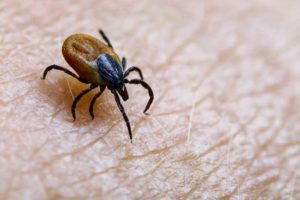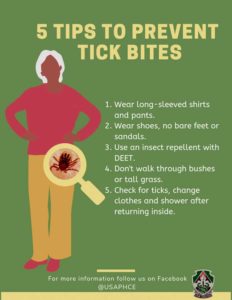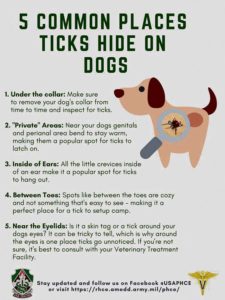
The outdoors can certainly be great, but they also contain many insects and pests.
Among those are ticks, which can carry several potentially serious diseases. One of the most common is Lyme disease.
According to Public Health Command Europe officials, a person with Lyme disease may develop fever, headache, fatigue, and a skin rash. This rash is sometimes referred to as a “bulls-eye” rash because it is red and circular in appearance. In most cases, Lyme disease can be treated with antibiotics. However, if the disease is left untreated, it can worsen and cause a number of serious problems, to include facial paralysis and pain and numbness in the hands and feet.
“Ticks can be active on winter days when the ground temperatures are above 45 degrees Fahrenheit but they are most prevalent during warmer days,” said Maj. Amanda Cline, Chief of Entomology at PHCE.
So what do you do if you find a tick on you or your pet? Cline says ticks can be safely removed with tweezers.
“The first thing to do is to make sure you remove it properly,” she said. “Forget everything you have heard about removing ticks before now. All you need is a pair of sterile tweezers and simply pull at the mouthparts, or as close to the skin as possible, in a slow steady manner. Following removal, you should apply alcohol or an antibiotic ointment.”
Prevention is also important in protecting yourself and your family. Here are five tips to prevent tick bites:
- Wear long-sleeved shirts and pants when in wooded areas.
- Wear closed shoes — no bare feet or sandals.
- Use an insect repellent with DEET.
- Don’t walk through bushes or tall grass. Stay on marked trails, where possible
- After being outdoors, check for ticks. Shower and change your clothes.
Protecting yourself from ticks is important, but it is equally important not to forget about your furry family members.
“Having a pet dog or cat more than doubles the odds that humans will find a tick on themselves,” said Maj. Stephanie Kennedy, PHCE Regional Veterinary Clinical Medicine Officer and Consultant.
PHCE recommends that pets be treated for ticks year-round and encourages pet owners to talk with their local veterinary treatment facility to determine the best tick prevention for your pet.
“Along with tick prevention, pet owners are encouraged to check their pets for ticks daily, especially after they spend time outdoors,” Kennedy said. When checking your pet for ticks, don’t forget to check these five common places ticks hide on dogs:
- Under the collar: Make sure to remove your dog’s collar from time to time and inspect for ticks.
- “Private” areas: Make sure to check in the groin area between the back legs and underneath the tail. These are popular spots for ticks to hide.
- Inside of ears: All the little crevices inside of an ear make it a popular spot for ticks to hang out.
- Between toes: Spots like between the toes are cozy and not something that’s easy to see – making it a perfect place for a tick to setup camp.
- Near the eyelids: It can be tricky to tell, which is why around the eyes is one place ticks go unnoticed. If you’re not sure, it’s best to consult with your Veterinary Treatment Facility.
PHCE offers a free tick surveillance program which identifies and tests the ticks for the military and beneficiaries.
If you do find a tick on any member of your family, once removed, take the tick to your local medical treatment facility or for your furry friends, to the veterinary treatment facility. Be sure to have information on where you may have been bit and the date it was removed, so PHCE can capture the information.
Please do not send or bring ticks directly to Public Health Command Europe.
For more information on tick-borne illnesses and how to protect yourself and your family, please talk with your primary care manager or your pet’s veterinarian.


